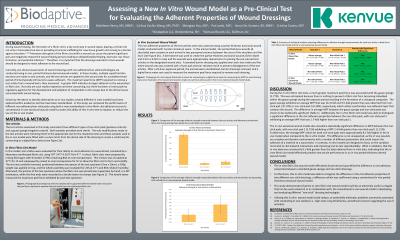Laboratory Research
(LR-020) Assessing a New in-vitro Wound Model as a Pre-clinical Test for Evaluating the Adherent Properties of Wound Dressings

Premature disruption of the fibrin clot within a wound can cause the patient significant pain and negatively impact the wound healing process leading to delayed/stalled healing, excessive scar tissue formation, and potential infection. Therefore, it’s important that the dressings selected to treat wounds should be designed to resist adhesion to the wound bed. Currently, pre-clinical assessments of wound dressings with non-adherent/non-stick technologies are conducted using in-vivo, partial-thickness dermal wound models. Not only are such studies expensive and time consuming, but there has been a recent push by regulatory agencies for the development and adoption of comparable in-vitro assays due to the ethical issues associated with animal testing. In this study, we compared the performance of different non-adherent/non-stick pads using both a new standardized in-vitro fibrin clot adhesion test and a conventional in-vivo wound model to assess the ability of this in-vitro test to replace the in-vivo model.
Methods: Two different non-stick pads and a gauze control were examined for their ability to resist adhesion to a simulated fibrin clot1, prepared by mixing fibrinogen with thrombin in PBS containing BSA at room temperature. The fibrin clots were sandwiched between two pieces of the test article and incubated for 24-hours. A tensile tester measured the average maximum peel force (MPF) exhibited by each test article. Additionally, each test article was examined using a conventional in-vivo partial-thickness, dermal wound model.
Results: The in-vitro model was able to appropriately distinguish the difference in wound adhesion strength of non-stick pads and gauze controls, which exhibited MPF of 0.17-0.29N and 2.77N, respectively. When examined using an in-vivo wound model, all test articles examined exhibited MPF that were consistently 10x greater, which is to be expected given the additional complexity of in-vivo models.
Discussion: This study demonstrates that the in-vitro wound model examined can be utilized to provide invaluable insight into how different “non-stick” dressing technologies/approaches would perform in an in-vivo environment. As such, adoption of this in-vitro model could reduce, or eliminate, problems commonly associated with conducting conventional in-vivo studies (i.e., high costs, long time frames, and ethical concerns regarding the use of animals).

.jpg)